182 Search Results for asha
June 19, 2014
by Carole Zangari -
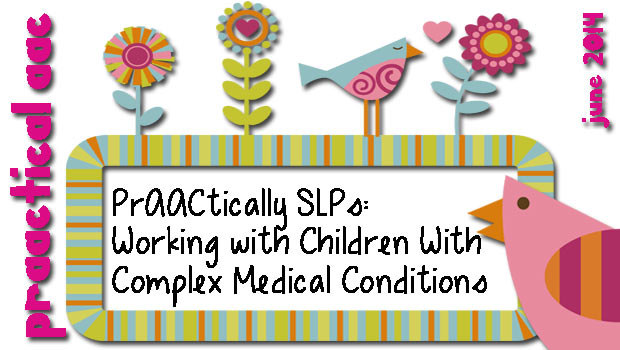
We are pleased to be sharing another post by a graduate student SLP. Stephanie Amundsen attends the SLP program at the University of Central Florida (UCF) and has worked for the Florida Alliance for Assistive Services and Technology (FAAST) Atlantic Regional Demonstration Center (ARDC) since May 2012. She is currently completing an externship working with children with complex communication needs, and is writing her thesis on AAC access in acute and sub-acute facilities. She has presented posters on service learning using AAC intervention and grammatical intervention using AAC under the direction of Dr. Kent-Walsh at the 2013 ASHA Convention, and has volunteered at the Assistive Technology Industry Association (ATIA) Conference in 2013 and 2014. :::::::::::::::::::::::::::::::::::::::::::::::::::::: As a graduate student placed in my first externship, I encountered multiple clients with AAC needs from day one. Because one of my placement sites is a Prescribed Pediatric Extended Care (PPEC) facility, many... [Read More...]
May 26, 2014
by Robin Parker -
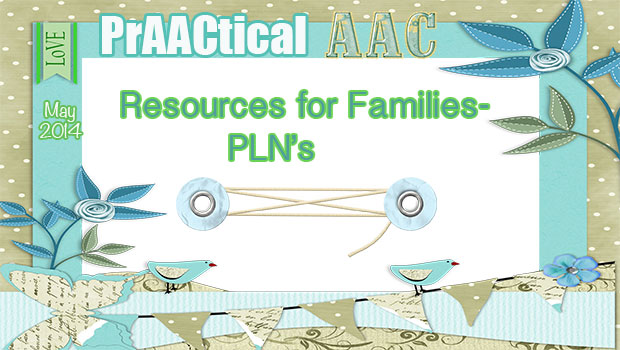
This month’s ‘Strategy of the Month’ has been focused on supporting families. To fully support families, it is essential to provide family friendly resources that can aid in creating Personal Learning Networks (PLN’s). The more families know and learn, the more likely the AAC learner will progress in their communication skills. Also, the more information families have, the better advocates they will become. And since families are one of the only constants in an AAC learner’s educational and life journey, the family is really the most important part the communication team. About AAC About AAC- ASHA AAC Institute- Parent’s Corner Center for AAC & Autism AAC -Family Resources Assistive Technology Resources- Autism Speaks Communication Matters Communication Books & Boards ConnectAbility http://www.setbc.org/pictureset/ Pre-made Communication Boards Help Designing Communication Books Free & Discounted AAC Apps Appy Malls Smart Apps for Kids Moms with Apps The iMums Apps Wheel *(categorized wheel of apps to... [Read More...]
May 21, 2014
by Carole Zangari -
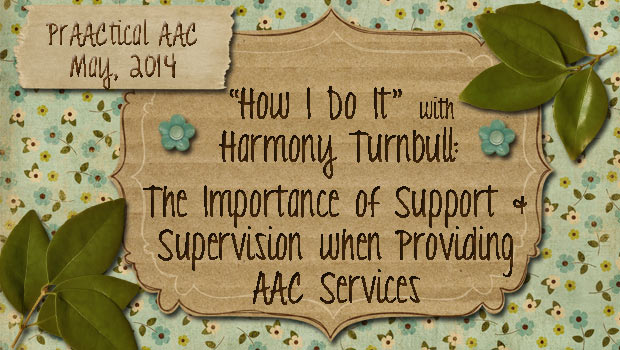
We are so thrilled to have a guest post today, from Australian SLP Harmony Turnbull. Harmony is a Consultant Speech Pathologist for Ageing, Disability and Home Care in NSW, Australia. In her role, she provides support and supervision to senior speech pathologists, carries a small caseload of people with complex needs and provides expert consultancy for management. She has specialised in supporting people with disabilities including complex communication needs for 11 years and is addicted to networking. She can often be found sharing her knowledge and asking many questions on Facebook and Twitter (@SP_Harmony). Harmony is passionate about the work speech/language pathologists can do to improve the quality of life for people with disabilities. The Importance of Support and Supervision when Providing AAC Services Scenario – Jane Jane is an SLP who has been working with people with disabilities for over 5 years, including people with complex communication needs. Her caseload... [Read More...]
May 14, 2014
by Robin Parker -
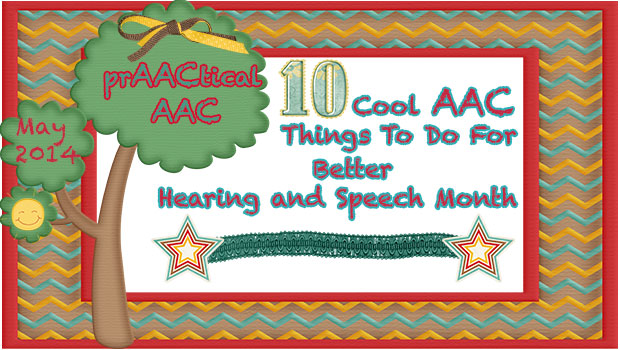
Learn with AbleNet University. Watch excellent free AAC webinars. There are live and recorded webinars so you can learn at your convenience. Share the information with colleagues and families. Give an AAC Gift. Create AAC informational bookmarks and distribute to educators, staff, and families. Print some free communication boards. Go to the PrAACtical AAC e-Tool Box and print out some great core word or activity specific communication boards. Put in your AAC clinic tool box or share with educators or families. Debunk AAC Myths. Use our AAC Myth buster quotes. Print and hang in public spaces so everyone can be an AAC myth buster. Learn and PrAACtice a New AAC System (device or app). Go to prAACtical AAC’s Teach Me Tuesdays and choose an app or device to learn- (Alexicom, Proloquo2go, PRC Accent, The Grid, Tap Speak Button & Sequence, Avaz, Tobii C8, Proloquo4Text, Go Talk Now Text, Nova... [Read More...]
April 25, 2014
by Robin Parker -
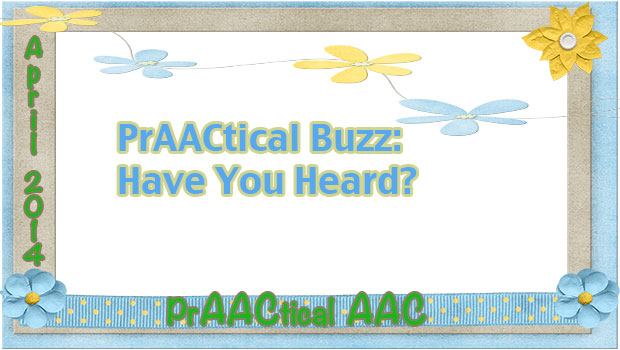
There is a lot of prAACtical buzz around 2 AAC apps that have recently released free/lite versions Check them out: Avaz Lite Version- AAC App for Autism (Augmentative Picture Communication Software for Children with Special Needs)- Try out Avaz AAC app with the lite version and a 7-day promotional subscription period to the symbols and voices which can be used for decision making options. Learn more about the full version at Avaz Support. Dynavox Compass (try for 30 days or full version for ASHA Certified Professionals)- A full version for professionals with weekly resource emails with videos and tips to help learn the full potential of the app. Other long standing free and lite versions: 133 Free or Lite Versions of AAC Apps
March 25, 2014
by Carole Zangari -
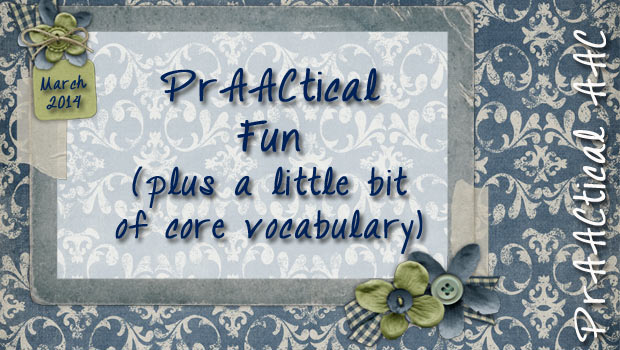
It was so gratifying so be at the most recent ASHA and ATIA conferences and notice how many presentations covered some aspect of core vocabulary. The shift away from noun-heavy, activity-based vocabulary has gained significant momentum. Teams who are deeply invested in teaching core words find that it becomes a way of thinking. Still, it’s not as easy as it seems to use core words. We found this fun site that we thought you might like, too. It challenges you to explain or discuss something using only the more frequent 1,000 words. Check out these examples, then try your hand at using core words to explain how to make a favorite recipe, explain what you did at work today, or teach a lesson. If someone can summarize a whole movie or doctoral dissertation with core words, shouldn’t we be able to model them when we speak to AAC learners throughout... [Read More...]
March 5, 2014
by Carole Zangari -
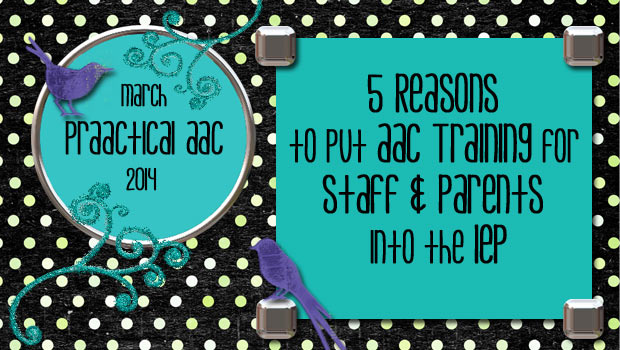
SLPs tend to love (good, relevant) professional development. We flock to conferences (15,000+ ASHA attendees this past November), sign up for workshops, and attend webinars. But for some reason, we are reluctant to request training as part of the IEP process, even when we’re not very confident in our work with the student. Maybe we don’t want to acknowledge our need for it, or admit that there is something we don’t know (gasp!). Perhaps we’d just rather not make waves. We may ask for training informally, but it doesn’t always get tied to specific students’ IEPs, and that may mean that our requests get overlooked. Here are a few reasons why you may want to put staff training into IEPs when needed. We need it. The complexity of the AAC field, diversity of this clinical population, and the rapid pace of change in technology make it very unlikely that any... [Read More...]
January 27, 2014
by Robin Parker -
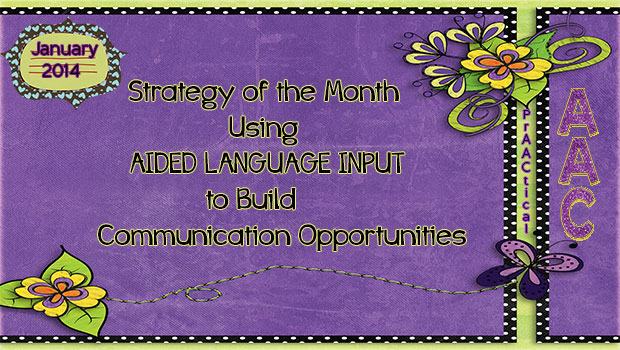
We can not write, speak or do enough Aided Language Input (ALI). If we expect learners to speak AAC, we must speak AAC to them. It is difficult enough to learn a language and imagine if no one spoke it to you in the language you were expected to speak…But there are so many more reasons to do ALI. Aided Language Input (ALI) belongs in the context of communication opportunities. It is modeling AAC style. Once we model a target language concept AAC style, then add the wait and signal strategy, the learner then knows it is their communicative turn. Especially if you wait with the raised eye brow signal. They often will take their turn expressively. But, if they do not take the communicative opportunity to take their turn, there are gestural, visual, verbal, and physical prompts that can be implemented. In other words, they can make use of... [Read More...]
January 22, 2014
by Carole Zangari -
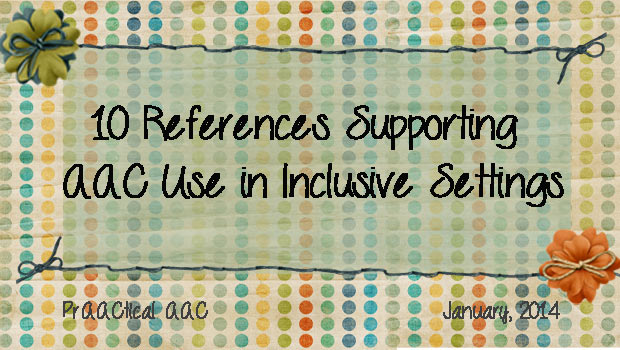
We sometimes get contacted by colleagues who are looking for references supporting the use of AAC. Here are some that are specific to inclusive settings in schools and in the community.* Alquraini, T., & Gut, D. (2012). Critical components of successful inclusion of students with severe disabilities: Literature review. International Journal of Special Education, 27(1), 42-59. Balandin, S., & Duchan, J. (2007). Communication: Access to inclusion. Journal of Intellectual and Developmental Disability, 32(4), 230-232. Batorowicz, B., Mcdougall, S., & Shepherd, T. A. (2006). AAC and community partnerships: The participation path to community inclusion. Augmentative and Alternative Communication, 22(3), 178-195. Calculator, S. (2009). Augmentative and alternative communication (AAC) and inclusive education for students with the most severe disabilities. International Journal of Inclusive Education, 13 (1) 93-113. Carter, M., & Maxwell, K., (1998). Promoting interaction with children using augmentative communication through peer-directed intervention. International Journal of Disability, Development, and Education 45(1) 75-96. Daugherty,... [Read More...]
December 6, 2013
by Carole Zangari -
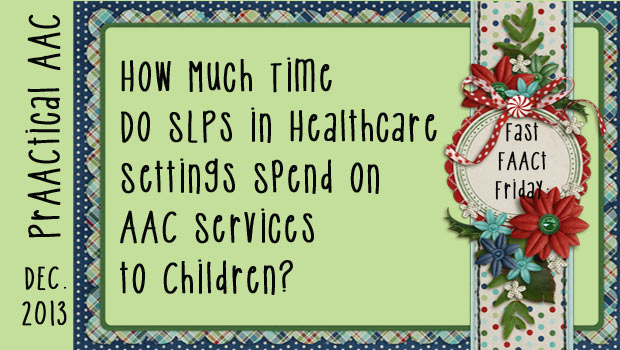
In the US, you’d be hard pressed to find a graduate program in SLP that didn’t have required courses in fluency and voice disorders. Only a minority of SLP programs, though, require students to take a course in AAC. How does this compare to the needs in the field? Not so well, in our humble opinion. ASHA’s 2013 SLP Health Care Survey obtained responses from more than 800 SLPs who work with children in healthcare settings, such as hospitals, outpatient clinics, and home health. On average, they spent more time on AAC services than on services for fluency, voice, or resonance disorders. When asked what percentage of their time was spent providing services in different categories, here’s what the participating SLPs reported: AAC: 5.5% Fluency: 3% Voice: 2% Resonance: 1.3% We acknowledge that requiring graduate students to take courses in specific disorder areas isn’t the only way to help them... [Read More...]









